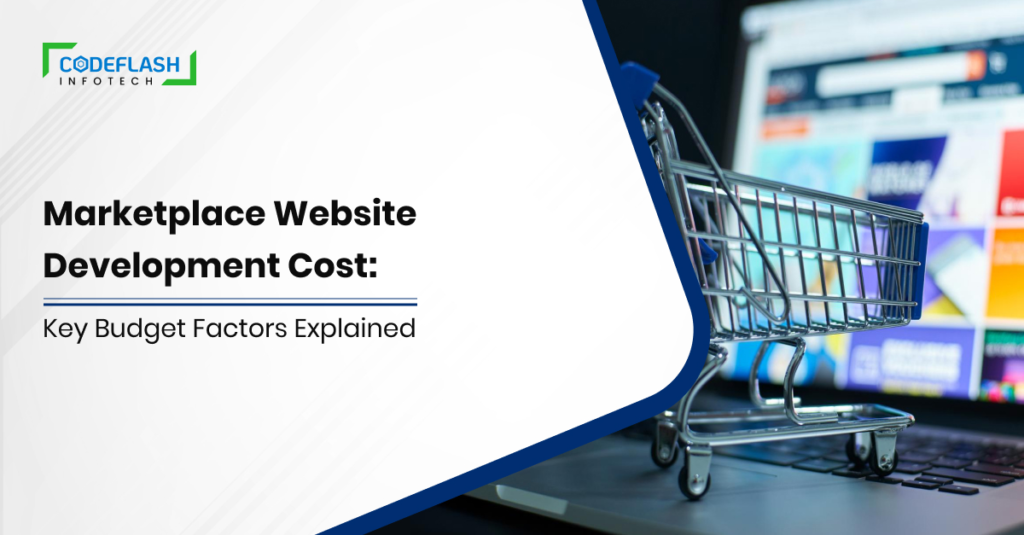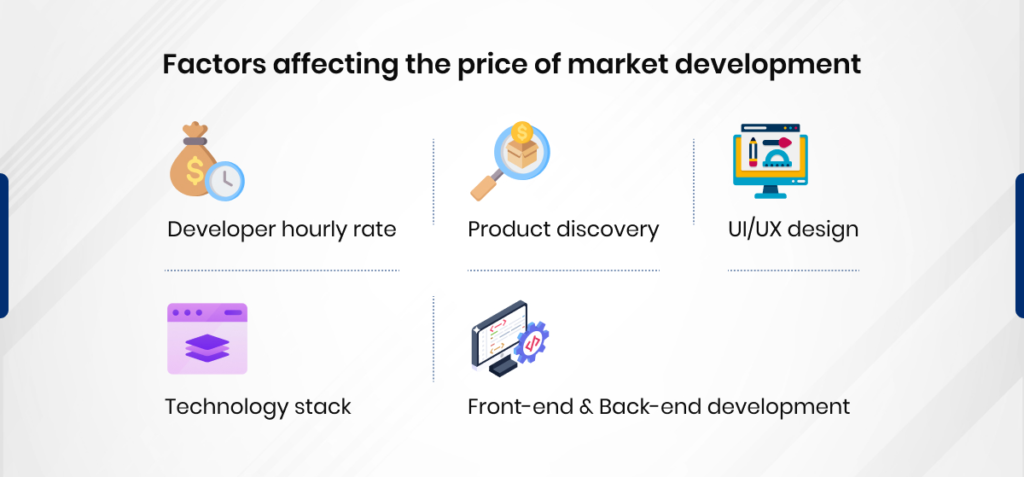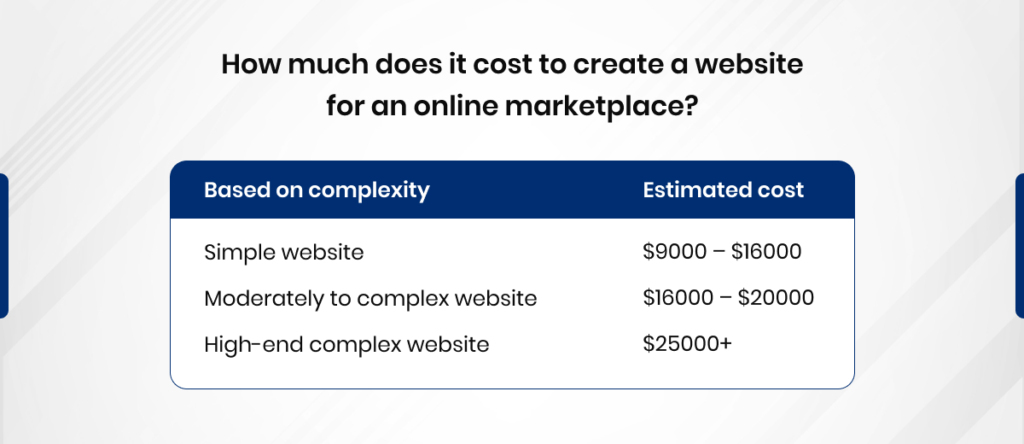
Marketplace Website Development Cost: Key Budget Factors Explained
11 OCTOBER
Amazon revolutionized online shopping back in 2000, paving the way for a multitude of e-commerce platforms that we now utilize to find nearly everything we need. Once you experience the convenience of online shopping, there’s no going back to traditional brick-and-mortar stores.
Forecasts predict that in 2024, the number of online buyers will reach 282.7 million, with a compound annual growth rate of 1.5% from 2017 to 2024. This makes now the perfect time to launch an online marketplace. The key lies in creating a marketplace website that resonates with your target audience.
You might wonder about the marketplace website development cost and the necessary steps to ensure your project’s success. Various experts agree that the overall cost of building a marketplace from scratch depends significantly on its features and functionalities.
Incorporating advanced technologies like artificial intelligence and machine learning can enhance personalization and improve the online shopping experience. Additionally, leveraging Big Data solutions allows you to process large volumes of information, optimizing your marketplace services. Moreover, using blockchain technology can ensure secure online payments and transparency in transactions.
In this article, we will discuss the marketplace website development cost in detail. If you’re aiming for outstanding e-commerce results, keep reading!
What is an Online Marketplace Website?
Online marketplace website is the leading site where customers may look for products that merchants have posted. The website also offers access to payment hubs, shipping options, and chat services.
To create an online marketplace website, a firm has to work with a bespoke web development company. Through more sophisticated and adaptable marketplace website building, the company contributes to developing online marketplaces, facilitating the establishment of prosperous multi-vendor marketplace enterprises.
Types of online marketplaces
The kind you select influences the process of creating an online marketplace. Various marketplace kinds have their unique features, functions, and complexity.
These elements affect the time, money, and skills required for development, which involves the final cost of developing a marketplace website. Marketplaces are usually classified according to their participants and business models.
Based on the planned seller-buyer dynamic and your target market, your marketplace may fit into one of the following categories:
A third party frequently runs B2B marketplaces and offers goods or services in large quantities. A B2B marketplace website’s development expenses must consider elements like bespoke pricing, order processing complexity management, and smooth business-to-business communication. eWorldTrade and Alibaba are two examples.
Businesses may conduct direct sales to consumers using B2C marketplaces. Their main priorities are the development of user-friendly interfaces, safe payment mechanisms, and efficient product listing and search features.
P2P or C2C marketplaces link people to exchange goods and services for cash or other resources. The cost of creating a peer-to-peer marketplace is mainly determined by factors like easy-to-use listings, safe payment methods, and proper facilities for buyers and sellers to communicate. Examples include BlaBlaCar, Uber, and Etsy.
Marketplaces for electronic commerce allow individuals and businesses to promote their products and services to a wide range of customers. Strong product catalogue management and multiple payment connections are necessary to facilitate this, which affects the total cost of constructing a marketplace. OLX, Amazon, and Poshmark are a few well-known examples.
mCommerce, or mobile marketplaces, are online shops created with mobile devices in mind. These platforms need to optimize their user interface and experience across various mobile devices and operating systems. Websites like Upwork, Sephora, and Jumia are a few examples of mobile-friendly ones.
Through crowdfunding platforms, users may raise funds for a specific project from the broader public. For these platforms, it is essential to implement safe payment methods and efficient campaign management tools. Examples of well-known crowdsourcing sites are GoFundMe, Indiegogo, and Kickstarter.
Auction platforms encourage customers to bid to compete for a good or service. The cost of creating an online auction marketplace is impacted by the requirements for running such marketplaces, which include a dynamic user interface, real-time bid updates, and strong security measures. A few instances are Artsy, Honcho, and eBay.

Factors Affecting the Price of Market Development
An online marketplace project may be developed for $5,000 to $8,000. Naturally, this pricing is only available for essential, templated solutions. On the other hand, a specially designed platform will start at $10,000 or more.
Developing a custom marketplace website is typically contingent upon a few key elements. Let’s look at the variables that affect this budget most.
- Developer Hourly Rate
Some examples of mobile commerce sites include Jumia, Sephora, and Upwork.
A web developer’s hourly salary may range from $80 to $100 in the UAE. Eastern European countries have grown in popularity as locations for developers in recent years. Hiring software engineers from Ukraine, for instance, has shown to be more economical and time-effective than hiring from other nations.
2. Product discovery
A product discovery in website development may set the stage for practical and affordable website development solutions. A software consulting partner examines your marketplace’s business needs and history throughout this stage. Why does it matter so much? Businesses need discovery to steer clear of the following:
- Surpass their projected spending limit;
- Fail since their merchandise isn’t in demand.
- Lessen the end user’s value.
3. UI/UX design
A well-thought-out and user-friendly user interface is an additional element that may impact the cost of your upcoming marketplace website. This feature is essential since it improves the user experience, draws in and keeps users.
4. Technology Stack
A well-designed and user-friendly interface is a significant factor when considering marketplace website development costs. This element is essential for enhancing the user experience, which ultimately attracts and retains users. Key factors such as design complexity, the need for customization, and device responsiveness can influence the cost.
5. Front-end and Back-end Development
The technology stack you select for both front-end and back-end development is crucial in determining your marketplace website development cost. A robust front-end framework contributes to a seamless user experience, while an efficient back-end architecture ensures optimal functionality and performance. Keeping these aspects in balance is vital for controlling your marketplace website development cost and ensuring the success of your online marketplace.
Core features of an online marketplace MVP
- Registration and sign-in
While registered users can list goods or services, newbies require a mechanism to register on your platform. The simplest method is to manually input your email address and password, followed by an email confirmation. As an alternative, you can choose multi-factor authentication or make registration easier by using social logins on Google and other websites.
- Profiles
Users fill up their profiles with the relevant details, like the buyer’s information, product listings, and seller’s business name. While personalization options such as bio sections, profile images, and design modification help build trust, they also have an impact on the cost of developing a marketplace.
- Item listing
Vendors list their products. You can experiment with features like video uploads, modifying listing views, breadcrumbs for navigation, and social sharing buttons, or stick with the traditional image and text combination. Both the user experience and the total cost of the marketplace app are positively impacted by the additional complexity.
- Search
It makes using filters to navigate item listings easier. The cost of developing a marketplace app depends on search field’s complexity and intelligence. These options range from a simple text field to autocomplete recommendations and faceted search algorithms.
- Product page
You may decide to incorporate functions like live chat, user feedback, 3D models, GIFs, videos, and related products as you develop your marketplace app. Although it raises the cost of the marketplace app, it improves user involvement.
- Shopping cart
keeps selected but unpaid products. The functionality of the cart—mini or full page, one-page checkout, or step-by-step as well as the availability of assistance features or live support all have an impact on the cost of developing an e-commerce app.
- Payment
Users can submit their card information using various payment gateways and methods. However, the cost of development increases when multiple payment options, such as PayPal, Google Pay, and others, are integrated into the system, necessitating comprehensive payment gateway integration services.
- Administrator panel
Necessary for controlling content and giving owners the ability to change rules and regulations. By limiting the amount of work an admin can perform in this area, you can manage the cost of the marketplace app. An admin panel may only be used to control the content, moderate user behaviour, or even offer statistics.
- Shipping
Allows customers to examine and select their delivery alternatives. The total cost of developing a marketplace app includes shipping integration options like local delivery with geolocation capabilities or real-time carrier rates.

How Much Does It Cost To Create A Website For An Online Marketplace?
t would help if you were mindful of the price of developing a marketplace website. Even though creating a marketplace website is a costly procedure, it’s a fantastic option for a trustworthy and expanding business.
It would help if you thought about how much it will cost to create a marketplace website. For a stable and growing business, building a marketplace website is a terrific option despite the fact that it is a costly procedure.
It is feasible to create a marketplace that costs, on average, $8000 to $25000, similar to Airbnb. That being said, this pricing may be altered in accordance with the intricacy of the marketplace website
Why Choose Our E-commerce Developers?
Our Codeflash Infotech team offers unique e-commerce development services that are exclusively grounded in cutting-edge technologies and current trends. Our developers have already completed more than 100 e-commerce projects, and we have over 10+ years of experience in this field.
We are able to provide any kind of service, including development, testing, migration, and business analysis.
We are prepared to present a successful case study in which we contributed to the creation of an online marketplace. Our specialists conducted a thorough market analysis upon receiving a client’s request, and they concluded that there was no direct communication taking place between suppliers and customers.
Our experts developed a highly scalable, quickly loading hybrid platform. Here are some instances of corporate values:
- Six months following the product’s launch, revenue rises by 80%;
- Monthly growth in market share is 10%;
- The time needed for the manual work process was 90% less.
Conclusion
Several factors determine how much it costs to operate a website for an online marketplace. These variables include the platform’s functionality, hosting costs, security protocols, complexity and size, and customer support needs.
The online marketplace website can cost between 15% and 20% of the total cost of construction, on average. Additionally, the website’s functionality, user experience, and mobile responsiveness need to be updated and enhanced on a regular basis to keep a competitive edge in the market.
Therefore, it is recommended that you get help from a website development business. The professionals will assist you in maintaining your website for an extended period and will provide you with cost-effective maintenance tips.





